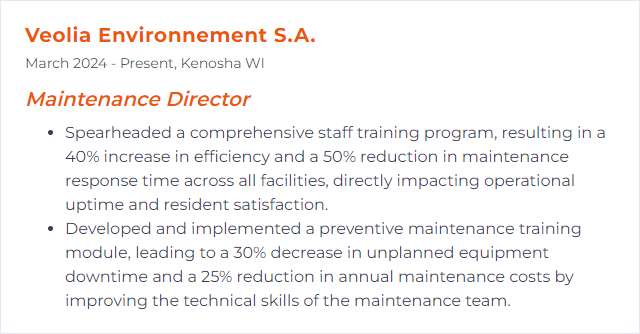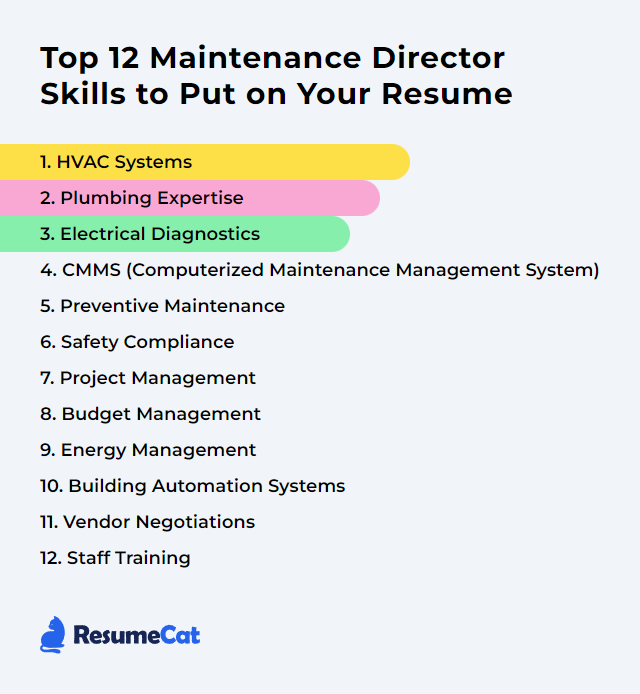Top 12 Maintenance Director Skills to Put on Your Resume
In the crowded world of facilities and operations, a Maintenance Director wins by blending sharp technical knowledge with crisp leadership and relentless follow-through. A resume that broadcasts those strengths—clearly, credibly—pulls hiring managers in and sets the stage for roles where strategy, uptime, and cost control make the difference.
Maintenance Director Skills
- HVAC Systems
- Plumbing Expertise
- Electrical Diagnostics
- CMMS (Computerized Maintenance Management System)
- Preventive Maintenance
- Safety Compliance
- Project Management
- Budget Management
- Energy Management
- Building Automation Systems
- Vendor Negotiations
- Staff Training
1. HVAC Systems
Heating, ventilation, and air conditioning keep buildings breathable, stable, and sane. For a Maintenance Director, HVAC is core infrastructure—comfort, air quality, and reliability wrapped into one large, energy-hungry system that can either run smoothly or bleed cash.
Why It's Important
Because indoor air quality, thermal comfort, and safety ride on it. Because energy costs spike when it’s ignored. And because compliance and occupant satisfaction follow when it’s tuned and watched.
How to Improve HVAC Systems Skills
Sharper HVAC practice comes from method, data, and disciplined upkeep:
Routine care: Clean coils, replace filters, verify airflow, and keep fans balanced. Small tasks, big gains.
High-efficiency equipment: Upgrade aging units, add heat recovery, and right-size systems to reduce load and waste.
Smart controls: Use programmable controls, occupancy-based scheduling, and setbacks; tie them into BAS for unified logic.
Tight envelope: Seal and insulate. Leaks punish compressors and budgets alike.
Ductwork discipline: Test, seal, and insulate ducts. Verify static pressure and distribution, not just nameplate capacity.
Energy reviews: Run periodic energy checks; benchmark performance and hunt drift.
Low-carbon options: Consider variable refrigerant flow, high-efficiency heat pumps, and heat recovery; plan for refrigerant phase-downs.
Standards and training: Align with ASHRAE guidance (comfort, ventilation, filtration) and keep team certifications current.
Do this and systems run quieter, cleaner, cheaper.
How to Display HVAC Systems Skills on Your Resume

2. Plumbing Expertise
Piping, fixtures, valves, pumps—potable in, waste out, no cross-contamination. It’s safety and sanitation wrapped into a maze you must understand and control.
Why It's Important
Leaks wreck structures, water quality failures risk health, and out-of-code work invites fines. Tight plumbing cuts emergencies and downtime while protecting the building.
How to Improve Plumbing Expertise Skills
Keep current on codes: Track updates to plumbing and mechanical codes; document local AHJ requirements and test procedures.
Hands-on repetition: Shadow seasoned techs, perform supervised installs and repairs, and build a catalog of standard details that actually work.
Professional networks: Engage with trade associations and peer groups; swap lessons learned and verify best practices before standardizing.
Practical knowledge plus code fluency beats guesswork every time.
How to Display Plumbing Expertise Skills on Your Resume
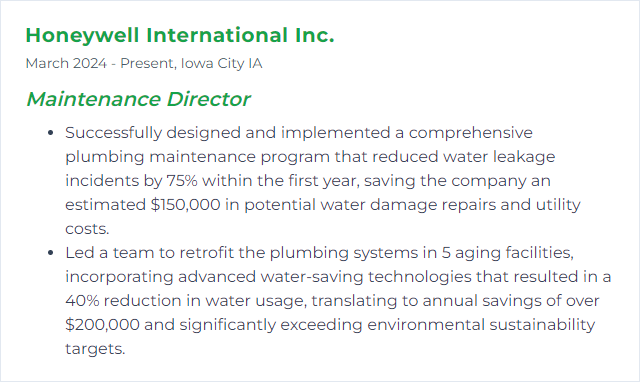
3. Electrical Diagnostics
Finding faults before they find you. Testing, tracing, and interpreting signals so power systems behave and stay safe.
Why It's Important
Because electrical failures escalate—fast. Early detection avoids fire risk, protects equipment life, and keeps production steady.
How to Improve Electrical Diagnostics Skills
Targeted training: Deepen skills in motor controls, VFDs, power quality, and arc flash boundaries; refresh annually.
Right tools: Maintain calibrated meters, insulation testers, thermal imaging, and (where appropriate) oscilloscopes; standardize toolkits.
CMMS/EAM discipline: Log findings, trend temperatures and loads, and connect symptoms to root causes—not just work orders.
Predictive tactics: Use infrared scans, vibration checks, and motor circuit testing to move issues from “surprise” to “scheduled.”
Standard procedures: Create step-by-step diagnostics for common systems; baseline normal readings and update after modifications.
Safety first: Follow OSHA electrical safety rules and the NFPA 70B standard for maintenance; enforce lockout/tagout and PPE without compromise.
Clarity in process yields clarity in results.
How to Display Electrical Diagnostics Skills on Your Resume

4. CMMS (Computerized Maintenance Management System)
Your maintenance command center. Assets, parts, work orders, schedules, costs—all captured, all reportable, all auditable.
Why It's Important
Because visibility defeats chaos. A good CMMS lifts uptime, trims spend, and turns “we think” into “we know.”
How to Improve CMMS (Computerized Maintenance Management System) Skills
Audit the setup: Confirm asset hierarchies, naming conventions, and PM libraries reflect reality; prune obsolete data.
Data governance: Define required fields, ownership, and update cadence; measure data quality and fix gaps.
Integrate wisely: Connect with ERP, BMS/BAS, sensors, and inventory systems so data flows instead of duplicating.
Customize dashboards: Build role-based views and reports; highlight backlog, compliance, MTBF/MTTR, and cost drivers.
Train relentlessly: Provide practical, scenario-based training; create quick-reference guides and champions on each shift.
Preventive and predictive: Convert run-to-failure tasks into PM/PdM; trigger work from condition data, not just calendars.
Track KPIs: Review schedule compliance, wrench time, emergency work mix, and inventory turns; adjust plans monthly.
When the CMMS reflects the plant’s truth, decision-making gets easier.
How to Display CMMS (Computerized Maintenance Management System) Skills on Your Resume
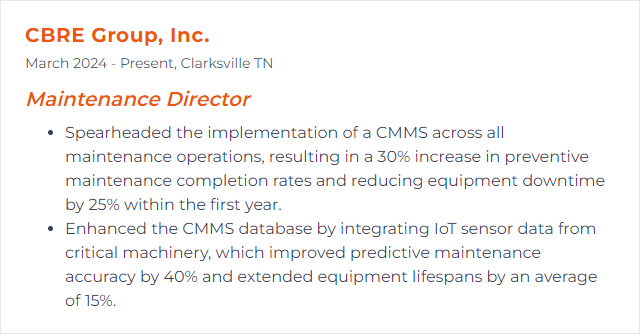
5. Preventive Maintenance
Planned work that keeps assets steady and failures rare. Less drama, more uptime.
Why It's Important
PM reduces surprise breakdowns, stretches asset life, and keeps costs predictable—exactly what operations and finance both want.
How to Improve Preventive Maintenance Skills
Baseline the program: Map current PMs, find duplicates and gaps, and compare with OEM and field experience.
Leverage CMMS/EAM: Automate schedules, standardize job plans, and capture completion evidence and findings.
Blend in predictive: Add condition monitoring—vibration, ultrasound, oil analysis, thermography—to target the right work at the right time.
Standardize procedures: Create clear job steps with tools, parts, safety notes, and pass/fail criteria.
Train and rotate: Cross-train techs, verify competencies, and rotate complex PMs to prevent single points of failure.
Use reliability methods: Employ RCM and FMEA to focus on failure modes that matter, not busywork.
Review the data: Analyze recurring defects, adjust intervals, and retire PMs that no longer deliver value.
Verify results: Track downtime, emergency work percentage, and cost per asset to prove improvement.
How to Display Preventive Maintenance Skills on Your Resume
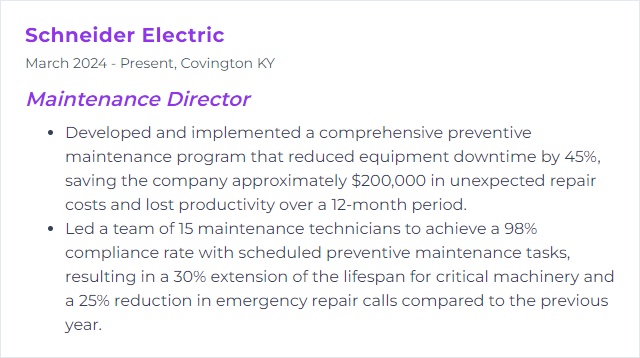
6. Safety Compliance
Safe work is the floor, not the ceiling. Compliance is proof you’re serious and consistent.
Why It's Important
People go home in one piece. Regulators stay satisfied. Insurance claims shrink. Operations stay open.
How to Improve Safety Compliance Skills
Train with purpose: Job-specific, scenario-based training that sticks; refreshers scheduled, not forgotten.
Audit relentlessly: Layer inspections—behavioral, equipment, and process—and close corrective actions fast.
Lockout/tagout mastery: Document energy control procedures, verify devices, and audit execution regularly.
Permits and SOPs: Hot work, confined space, elevated work—tight controls, clear checklists, real oversight.
Near-miss culture: Encourage reporting, respond without blame, and fix systems instead of pointing fingers.
Know the rules: Track OSHA and local requirements; update programs when standards change.
Consistency beats posters on the wall.
How to Display Safety Compliance Skills on Your Resume

7. Project Management
Scope, schedule, cost, risk. Herding tasks and people so outcomes land where they should.
Why It's Important
Well-run projects minimize downtime, hit budgets, and deliver assets that work on day one—not after a month of patching.
How to Improve Project Management Skills
Pick a framework: Blend Lean, Agile, or stage-gate methods to match maintenance realities and shutdown windows.
Use the right tools: A simple, shared project tracker beats scattered spreadsheets; ensure everyone can see the plan.
Tight communication: Stand-ups, milestone reviews, and clear RACI; no mysteries about who owns what.
Risk first: Identify critical path items and long-lead materials early; stock contingencies and backup plans.
Control scope: Document changes, price them, and keep a clean trail; avoid stealth scope creep.
Data-driven visibility: Track earned value, burn rates, and schedule variance; escalate issues before they harden.
Learn and improve: Run post-mortems; fold lessons into templates and playbooks.
How to Display Project Management Skills on Your Resume
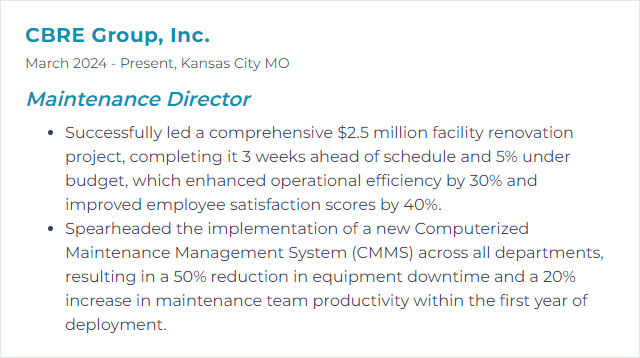
8. Budget Management
Plan the spend, track the drift, hit the target. Every dollar needs a job.
Why It's Important
Maintenance costs can sprawl. Controlled budgets extend asset life, cut emergencies, and keep leadership confident that money is working, not just leaving.
How to Improve Budget Management Skills
Define outcomes: Tie budget lines to clear goals—compliance, uptime, risk reduction—so trade-offs are obvious.
Forecast with history: Use past failures, seasonality, and project pipelines to model needs; build realistic reserves.
Prioritize ruthlessly: Fund safety and critical assets first; defer nice-to-haves when realities bite.
CMMS/EAM cost tracking: Code labor, parts, and contractors to assets; roll up costs by system and site.
Review monthly: Variance analysis, course corrections, and action plans—no surprises at quarter-end.
Inventory control: Apply ABC analysis, set min/max levels, and clean dead stock; standardize parts where possible.
Train the team: Teach techs the cost impact of choices; reinforce repair vs. replace logic with data.
Invest to save: Preventive and energy projects that pay back quickly deserve fast lanes.
Negotiate smart: Consolidate spend, seek multi-year pricing, and bake SLAs into contracts.
Leverage technology: Use submeters, EMS, and reporting tools to pinpoint waste and validate savings.
How to Display Budget Management Skills on Your Resume
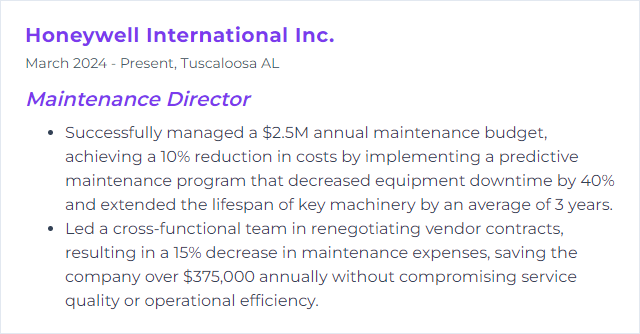
9. Energy Management
Watch the kilowatts, cut the peaks, and turn waste into wins. Comfort stays up while spend goes down.
Why It's Important
Energy is a top controllable cost and a growing compliance target. Better management trims bills, reduces emissions, and extends equipment life.
How to Improve Energy Management Skills
Audit and benchmark: Map loads, check run hours, and compare performance to similar sites; find the outliers.
Tackle quick wins: LED retrofits, smart scheduling, setpoint discipline, and variable speed drives—fast paybacks add momentum.
Maintain for efficiency: Clean heat exchangers, calibrate sensors, and verify controls; efficiency slips without care.
Engage people: Train operators and occupants; reward ideas that cut usage without hurting outcomes.
Monitor continuously: Use EMS and submeters to track real-time consumption; alarm against drift and demand spikes.
Consider renewables: Evaluate on-site solar, storage, or thermal recovery where it pencils out; align with utility programs.
Policy and targets: Set reduction goals, assign ownership, and report progress; align with local benchmarking rules if applicable.
Measure. Act. Measure again. Then lock in the gains.
How to Display Energy Management Skills on Your Resume
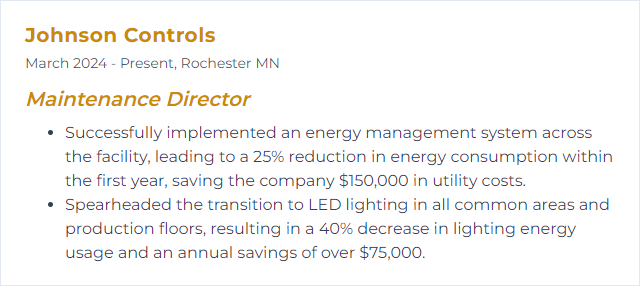
10. Building Automation Systems
The digital backbone that coordinates HVAC, lighting, security, and more. Data flows in, decisions flow out.
Why It's Important
BAS unlocks consistent comfort, reduced consumption, and proactive maintenance. When it’s tuned, the building feels smarter—and is.
How to Improve Building Automation Systems Skills
Integrate subsystems: Pull HVAC, lighting, metering, and access into one coherent platform; avoid islands of control.
Keep it current: Update firmware and software, harden configurations, and retire deprecated protocols.
Train operators: Teach trending, alarming, and overrides; limit who can change setpoints and sequences.
Preventive routines: Test sensors, recalibrate regularly, and validate sequences of operation after changes.
Energy analytics: Trend KPIs, compare against models, and auto-detect anomalies; fix the root causes, not the symptoms.
Cybersecurity: Segment networks, patch routinely, and enforce strong access controls; monitor for odd traffic.
IoT and condition data: Add sensors where blind spots exist and feed insights into PM/PdM programs.
The building will tell you what it needs—if you wire it to speak and listen.
How to Display Building Automation Systems Skills on Your Resume
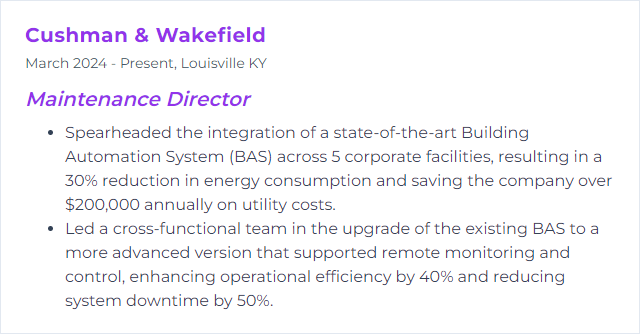
11. Vendor Negotiations
Getting the right materials and services at the right time and price—without sacrificing quality or speed.
Why It's Important
Smart deals stretch budgets, stabilize lead times, and hold partners accountable when it counts.
How to Improve Vendor Negotiations Skills
Prep hard: Know your demand profile, alternatives, and constraints; walk in with data, not hope.
Build rapport: Long-term partners deliver during crunch time; treat them like part of the operation, not just a PO number.
Communicate clearly: Spell out specs, delivery windows, service levels, and penalties; ambiguity is expensive.
Competitive tension: Use structured bids and clean comparisons; reward value, not just price.
Aim win–win: Secure price protections while offering volume commitments or longer terms where justified.
Think total cost: Include freight, lead time, reliability, and warranty support; cheapest often isn’t least expensive.
Good contracts set expectations. Great ones set behaviors.
How to Display Vendor Negotiations Skills on Your Resume

12. Staff Training
The multiplier. Skill-up a team and everything else moves easier.
Why It's Important
Trained technicians solve problems faster, safer, and with less rework. Compliance improves. Morale does too.
How to Improve Staff Training Skills
Assess gaps: Map current skills to required competencies; prioritize by risk and business impact.
Blend learning: Mix hands-on coaching, classroom, microlearning, and vendor demos; teach on the asset, not just the whiteboard.
Use an LMS: Track certifications, expirations, and course completion; make development visible.
Safety first: Hardwire LOTO, hazard recognition, and permits into every training plan and toolbox talk.
Grow soft skills: Communication, troubleshooting, and leadership turn good techs into anchors for the team.
Feedback loops: Evaluate training impact on KPIs; adjust content and cadence; celebrate improvements.
Career paths: Define progression ladders with clear criteria; retention rises when growth is real.
How to Display Staff Training Skills on Your Resume
